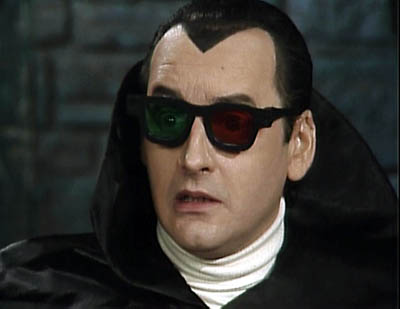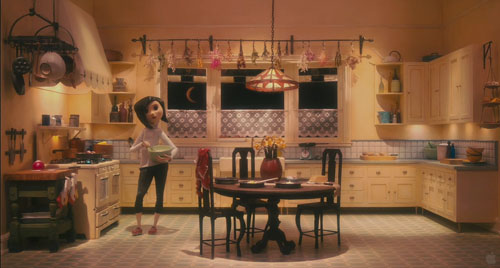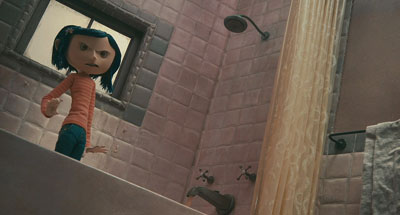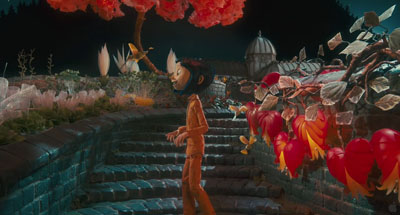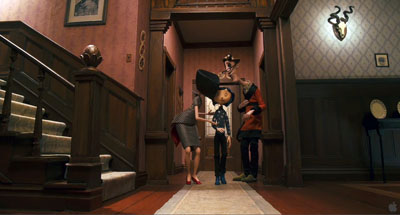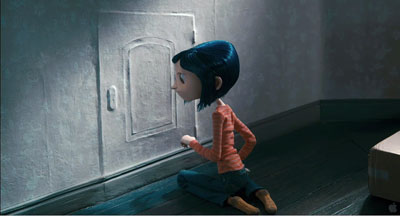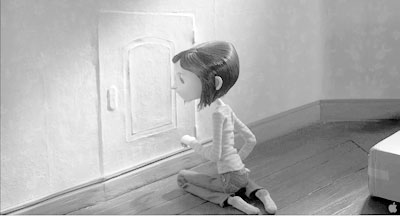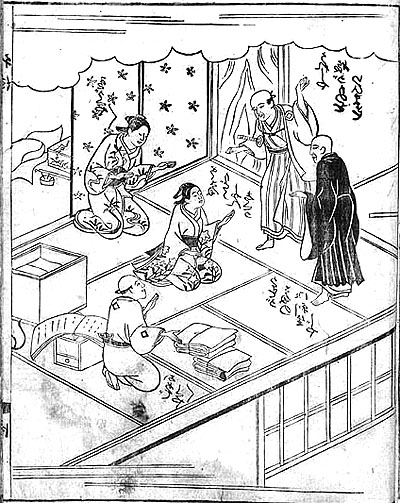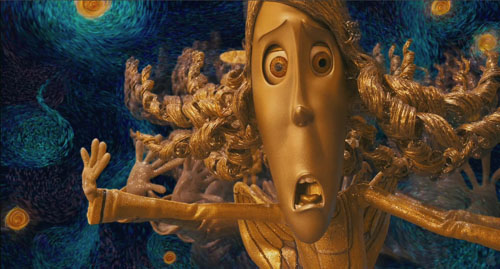Archive for the '3D' Category
Coraline, cornered
DB here:
It’s common for academics in one field to borrow ideas from other domains of research. But people outside academe sometimes object when a film scholar talks about movies using a term or idea originating elsewhere. These people usually think of themselves as hard-headed pros. Everything we need to understand film, they think, can be derived from the concepts already used by practitioners.
No doubt, we should be attentive to the ways in which filmmakers think and talk about their work. There’s a lot to be learned from shop talk and insider information–hence the enduring value of interviews, DVD commentaries, and the like. Yet no activity explains itself. Often practitioners do things intuitively, without making their background ideas explicit. We can often illuminate a filmmaker’s creative choices by spelling out the unspoken premises behind the work.
Further, filmmakers themselves have traditionally drawn ideas from other arts and sciences. For example, storytelling techniques referred to as exposition, point of view, or motivation have their origin in theories of literature and drama. Filmmakers have been quite pluralistic in their creative practices; why can’t critics and historians be open to outside influences?
Back in the 1980s I began speculating on how the film image represented space, and I adopted the then-current terminology of perceptual psychology. Researchers spoke of depth cues, those features of the real world that prompt our visual system to make fast inferences about a three-dimensional layout. Classic depth cues are the Gestalters’ figure/ ground relation, da Vinci’s “atmospheric perspective” (the haze that envelops more distant planes), and Helmholtz’s “kinetic depth effect,” the way that when you’re moving, closer objects change at a different rate than more distant ones.
These features can also be invoked in two-dimensional images, as I tried to show in Narration in the Fiction Film. Nowadays, deeper explanations of these effects are available using geometrical or computational approaches to perception. But depth cues remain a useful informal way of studying how artists manipulate images. For this reason, in Film Art: An Introduction, we’ve continued to itemize some depth cues that are important in cinema. These concepts furnish analytical tools for understanding things that filmmakers do spontaneously when they compose or light a shot.
So imagine my happiness when I hear filmmakers talk directly about depth cues.
In a fascinating article in American Cinematographer, Pete Kozachik, Director of Photography on Coraline, explains that the filmmakers were very conscious of perceptual factors throughout, and not just in creating the stereoscopic effect. For example, they designed and filmed our heroine’s alternative world in normal perspective, but her boring normal world was designed to seem off-kilter and flat by means of inconsistent depth cues within the shots. “The compositions match in 2-D, but the 3-D depth cues evoke a different feel for each room.”
This is hard to illustrate in a two-dimensional medium, but the Coraline trailer offers some examples. Consider this image.
The tiles in the family shower don’t recede into the distance, either across or upward. They are more or less the same size, just arrayed along a diagonal. A degree of recession is supplied by tonality and lighting, but the corner of the shower stall remains somewhat ambiguous. If you try to do a Gestalt flip, you can see the corner as a chimney poking out at you rather than one receding inward. (To see this, try covering the rest of the shot with your hands.)
In the garden of the “Good Household,” however, the bricks recede naturalistically in shape and size. The lighting and tonal gradients create a strong sense of depth.
Here is the Good Family’s hallway.
It displays central perspective, with everything receding as it should (as if seen by a wide-angle lens).
By contrast, here is an oblique shot of Coraline’s real-world bedroom. The doorway’s edges recede pretty steeply, but the baseboard doesn’t taper as it moves toward and past the corner. Instead, it moves in parallel lines. The same thing is happening with the floor planks.
You can see the effect more clearly if we drain the color and lower the contrast. (Sorry, Messrs. Selick and Kozachik.)
Now you can also see the weird, almost cubistic edges of floorboards poking up just behind the carton. Again, lighting and tonality create a sense of depth that the geometry of the edges denies. The depth cues within Coraline’s normal life are inconsistent.
Stare at the rear stretch of the baseboard awhile, and you’ll find that its contours may look a bit wider than those in the foreground. This sort of “parallel perspective” can be found throughout Asian art. Here is a Japanese book illustration from 1713, in which many of the edges run in parallel perspective. Again, instead of meeting in the distance, diagonals seem to be converging out in front of the picture plane, making some areas appear wider in the rear than in the front.
If my invocation of other artistic traditions seems a highfalutin way of talking about an animated movie, check the Van Gogh joke in the Coraline frame at the bottom of this entry.
Kozachik also explains how he spent a lot of time trying to vary the two images’ interocular distance, the distance between our two eyes, in order to give a greater sense of volume. The care paid off, at least for me. Coraline is the best 3D film I’ve seen, as well as the scariest. (For our take on Beowulf see this entry.)
In addition, Coraline helps me push a general point: Cinema is at least partly an affair of perception. Filmmakers are practical psychologists, artists who have mastered the skill of playing with our senses. We can open up their secrets a little by using tools borrowed from the sciences of mind.
For more on Coraline, see Bill Desowitz’s Animation World interview with Tadahiro Uesugi and his interview with Henry Selick. Background on the production is supplied by Thomas J. McLean’s article from last year.
For an overview of spatial perception, see Maurice Hershenson, Visual Space Perception (MIT Press, 1999). A more detailed account is Stephen E. Palmer, Vision Science: Photons to Phenomenology (MIT Press, 1999). A geometrical explanation of the kinetic depth effect is offered in James E. Cutting, Perception with an Eye for Motion (MIT Press, 1986).
Bwana Beowulf
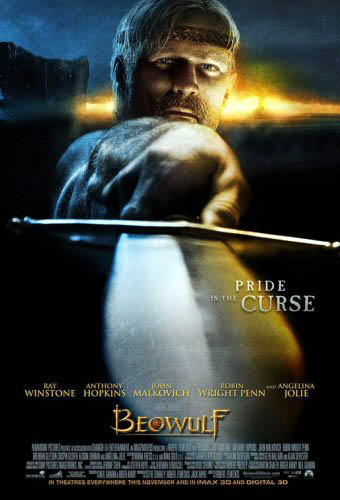
KT: I do not understand Beowulf. I don’t understand why the director who made one of the great modern Hollywood films, Back to the Future, and several very good ones, including Who Framed Roger Rabbit? and Cast Away, now has this fixation with creating nearly photo-realistic 3D digital images.
DB: I think that on the whole Zemeckis’ films have become weaker since Bob Gale stopped working with him. I like the sentiment of I Wanna Hold Your Hand and the crass misanthropy of Used Cars, and I think the Back to the Future trilogy mixes both in clever ways. But now almost every Zemeckis film seems to be less about telling a story than solving a technical problem. How to best merge cartoons and humans (Roger Rabbit)? How to push the edge of spfx (Death Becomes Her, Forrest Gump, Contact)? How to make half a movie showing only one character (Cast Away)? There’s a stunting aspect to this line of work, though I grant that it can lead to technical breakthroughs, as in Gump.
KT: I also don’t understand why most of the supposedly state-of-the-art effects technology looks distinctly cruder than the CGI in The Lord of the Rings, the first part of which came out six years ago. I don’t understand why studios that are trying to push 3D to a broad audience make a film with silly action aimed at teenage boys. That’s an OK strategy when you’ve got a $30 million horror film, but a budget of $150 million demands a lot broader appeal.
DB: And the evidence so far indicates Beowulf doesn’t have that appeal. The obvious comparison is 300, from earlier this year. According to Box Office Mojo it cost about $65 million to make, but it reaped $70 million domestically in its first weekend and wound up with $450 million theatrically worldwide. Beowulf grossed $27.5 million in its first US weekend and currently sits at about $146 million worldwide. I’d think that this has to be a disappointment. Recall too that the Imax screenings have higher ticket prices, so there are fewer eyeballs taking in Angelina Jolie’s pumps, braid, and upper respiratory area.
In addition, sources suggest that a 3-D version of Beowulf will not be available on DVD, so the sell-through takings—the real source of studio profit—may be significantly smaller than average.
KT: It seems to me that the people who are pushing 3-D so hard and hoping for it to become standard in filmmaking are forcing it on the public too soon. It’s still fiendishly difficult and expensive to shoot live action material in digital 3-D, so most projects are animated. One approach, taken in Beowulf, is to motion-capture real people and animate the characters to make them appear as much like the real people as possible. The problem is that they still have a weird look about them, like moving dolls. People have complained about the dead-eyed gaze of the characters in The Polar Express, and though there’s apparently been an improvement between the two films, the eyes don’t always look as though they’re focusing on anything. It can be done, though; the extended-edition Lord of the Rings DVD supplements about Gollum show how much effort went into making his eyes have a realistic sheen and flicker.
I was also struck by how clunky some of the animation looked. Beowulf is supposedly state of the art, and it certainly had the budget of a major CGI film. Yet some of the rendering and motion-capture was distractingly crude. I noticed that particularly on the horses. Their coats looked pre-Monsters, Inc., and their movements at times reminded me of kids rocking plastic toys back and forth. I suspect this effect had something to do with a lack of believable musculature. If you look at the way the cave troll was done in The Lord of the Rings: The Fellowship of the Ring (again, demonstrated in the DVD supplements), there was a specific program to simulate the way muscles move on skeletons, even the skeletons of imaginary creatures. Now, six years later, we see these things that look like hobby-horses—and that all run alike.
The backgrounds were often strange as well, simple and flat-looking, like painted backdrops. There were some exceptions, with the seascapes and rocky crags pretty realistically done. But just plain hillsides and groups of tents and so on looked almost sketchy in comparison with the moving figures, and I noticed that at times some fog would be put in, presumably to cover that problem up. There certainly was some very good animation as well, most notably the dragon, but there was no consistency of visual style.
DB: I’d go farther and say that 3-D hasn’t improved significantly since the 1950s. It ought to work: just replicate the eyes’ binocular disparity by setting two cameras at the proper interval or, now, by manipulating perspective with software. Yet in films 3-D has always looked weirdly wrong. It creates a cardboardy effect, capturing surfaces but not volumes. Real objects in depth have bulk, but in these movies, objects are just thin planes, slices of space set at different distances from us. If our ancestors had seen the world the way it looks in these movies, they probably wouldn’t have left many descendants.
It would take a perceptual psychologist to explain why 3-D looks fake. Whatever the cause, I’d speculate that good old 2-D cinema is better at suggesting volumes exactly because the cues to depth are less specific and so we can fill in the somewhat ambiguous array.
By the way, in watching a 3-D movie I seem to go through stages. First, there’s some adjustment to this very weird stimulus: I can’t easily focus on the whole image and movement seems excessively fuzzy. Then adaptation settles in and I can see the 2 ¼-D image pretty well. But adaptation carries me further and by the end of the movie I seem to see the image as less dimensional and more simply 2-D; the effects aren’t as striking. But maybe this is just me.
Back to the Future, or at least 1954
DB: I’d like to think about it from a historical perspective for a while. The industry seems to be repeating a cycle of efforts that took place in 1952-1954. The American box office plunged after 1947 as people strayed to other entertainments, including TV, and so the industry tried to woo them back with some new technology. Today, as viewers migrate to videogames, the Internet, and movies on portable devices, how can theatres woo their customers? Answer: Offer spectacle they can’t get at home.
Beowulf brings together at least three factors that eerily remind me of the early 1950s.
(1) Obviously, 3-D. The first successful 3-D feature era was Bwana Devil, released in November of 1952. It was an uninspired B movie, but it launched the brief 3-D craze. Columbia, Warners, and other studios made major pictures in the format, most notably House of Wax (1953). But costs of shooting and screening 3-D were high, with many technical glitches, and apart from novelty value, the process didn’t guarantee a big audience. The fad ended in spring of 1954, when all studios stopped making films in the format.
The process has been sporadically revived, notably in the 1980s (Comin’ at Ya, Jaws 3-D) and once more it fizzled. So, ignoring the lessons of history and chanting the mantra that Digital Changes Everything, we try it again.
(2) Big, big screens. In September of 1952, Cinerama burst on the scene with its huge tripartite screen and multitrack sound. It attracted plenty of viewers, but it could be used only in purpose-built venues. Like 3-D, its technology could never replace ordinary 35mm as the industry standard. The contemporary parallel is Imax, which though very impressive will not replace orthodox multiplex screens—too expensive to install and maintain, pricy tickets. Like 3-D, it’s a novelty. (1)
(3) The sword-and-sandal costume epic. It’s a long-running genre, but it got significantly revived in the late 1940s. It was a logical input for the new technologies of widescreen—not Cinerama but more practical offshoots that gained more general usage.
From the standard-format Samson and Delilah (1949), David and Bathsheba (1951), and Quo Vadis (1951) it was a short step to The Robe (1953) and The Egyptian (1954) in CinemaScope, The Ten Commandments (1956) in VistaVision, The Vikings (1958) in Technirama, Hercules (1959) in Dyaliscope, Solomon and Sheba (1959) and Spartacus (1960) in Super Technirama 70, and Ben-Hur (1959) in anamorphic 70mm Panavision. It is, incidentally, a pretty dire genre; the peplum might be the only genre that has given us no great films since Cabiria (1914) and Intolerance (1916).
In parallel fashion, the revival of the beefcake warrior film with Gladiator (2000) coincided with innovations in CGI and thus furnished new forms of spectacle for Troy (2004), Kingdom of Heaven (2005), and 300 (2007). This trend paved the way for Beowulf. When screens get bigger, Hollywood hankers for crowds, oiled biceps, big swords, and nubile ladies in filmy clothes. Not to mention soundtracks with pounding drums, wailing sopranos, and choirs chanting dead or made-up languages. And the conviction that Greeks, Romans, and those other ancient folks spoke with British accents. The innovation of Beowulf is to turn a Nordic hero into a Cockney pub brawler.
In other words, it’s 1954 again. So if we ask, Will it all last? I’m inclined to answer, Did 1954?
KT: Yes, the studios see the new technology as one more way to lure people away from their computers and game consoles and into the theaters. Maybe that will work to some extent. There’s no doubt that a lot of the people who have seen Beowulf have praised it as a fun experience and as having effectively immersive 3-D effects. I’m surprised at how many positive comments there are on Rotten Tomatoes, where the average score from both amateur and professional reviewers is 6.5 out of 10. That’s not exactly dazzling, but it’s a lot higher than I would give it.
Even so, the film hasn’t lured all that many people away from their other activities. You’ve mentioned that Beowulf hasn’t done all that well at the box-office. It did much better in theaters that showed it in 3-D. If it hadn’t been for the 3-D gimmickry, it would probably have been dead in the water from the start. And if 3-D effects remain on the level of gimmickry, they will soon wear out their welcome. Presumably the people who have been going to Beowulf are to a considerable extent those who are already interested in 3-D, and I can’t believe there are huge numbers of people really passionate about the idea of someday being able to watch lots of films in 3-D. If more films like Beowulf come out—ludicrous, bombastic action with distracting animation problems—they’re not likely to make the prospect any more attractive.
Eventually somebody—James Cameron or Peter Jackson, perhaps—will make the first great 3D film, and then maybe the passion will spread.
3-D in 2-D
DB: I’m doubtful that there will ever be a great 3-D film, and especially from those directors. But one last historical note.
I think that ordinary mainstream cinema has been setting us up for the flashiest 3-D flourishes for some time. One of the goals of the Speilberg-Lucas spearhead was to amp up physical action, to make it more kinetic, and this often showed up as in-your-face depth. Spielberg used a lot of deep-focus effects to create a punchy, almost comic-book look, and who can forget the opening shot of Star Wars, with that spacecraft arousing gasps by simply going on into depth forever? Seeing the movie in 70mm on release, I was struck by how the last sequence of Luke’s attack mission was maniacally concerned with driving our eye along the fast track of central perspective. Did it foreshadow the tunnel vision of videogame action?
In any case, I think that aggressive thrusting in and out of the frame was integral to the style of the new blockbuster. Since then, our eyes have been assaulted by plenty of would-be 3-D effects in 2-D. In Rennie Harlan’s Driven (2001), the crashing race cars spray us with fragments.
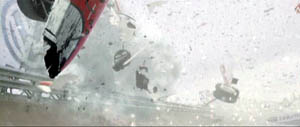
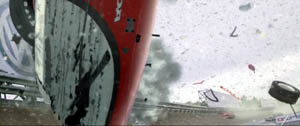
Jackson is definitely in the Spielberg line, favoring steep depth and big foreground elements. In King Kong, the primeval creatures lunge out at us, heave violently across the frame, and fling their victims into our laps.
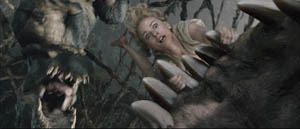
Such shock-and-awe shots recall American comic-book graphics. These affinities are at the center of 300, as we’d expect. For example, a cracking whip curls out at us in slow motion, like a two-panel series.
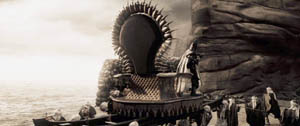
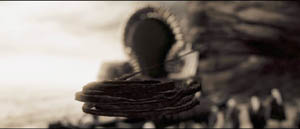
Beowulf draws on this thrusting imagery, but inevitably it doesn’t seem fresh because so many 2-D films have already used it. Maybe the most original device is having the camera pull swiftly back and back and back, letting new layers of foreground pop in and shrink away. This is viscerally arousing in 3-D, but aren’t there precedents for it—in the Rings, in animated films, or some such?
Zemeckis tries to transpose into 3-D the style of what I’ve called, in The Way Hollywood Tells It, intensified continuity. This style favors rapid cutting, many close views, extreme lens lengths, and lots of camera movement. I found Zemeckis’ restless camerawork even more distracting than in 2-D. So I’m wondering if current stylistic conventions can simply be transposed to 3-D, or do directors have to be more imaginative and make fresher choices?
KT: That pull-back effect may be viscerally arousing, but in Beowulf it was usually pretty gratuitous and, for me at least, it called attention to itself in a way that was often risible. I don’t think there’s anything in Rings as crude as the shots in Beowulf that you’re talking about. In the opening scene of the latter, in the mead-hall, the camera zips into the upper part of the room, with rafters, chains, torches, and even rats whizzing in from the sides of the frame. None of that contributes to the narrative.
The flashiest backward camera movement, or simulated camera movement, I can think of in Rings is the one in the Two Towers scene where Saruman exhorts his army of ten thousand Uruk-hai to battle. The final shot is a rapid track backward through the ranks of soldiers holding flag poles. The point is to stress the enormous numbers of soldiers. There’s no gratuitous thrusting-in of set elements from the sides, just the cumulative effect of so many similar figures. The simulated camera also at one point “bumps” one of the flagpoles, causing it to wobble, but I take it that that’s an attempt to add a certain odd realism to the “camera” movement, not a knowing nudge to the audience. In Rings, the virtual camera usually follows action rather than moving independently through space. It tends to go forward or obliquely rather than backward.
As to transferring classical Hollywood style to 3-D or finding a whole new set of conventions to fit 3-D, Beowulf offers an object lesson. It uses a combination of the two. At times we have conventional conversations using shot/reverse shot, and at other times we have the swoopy-glidey style you described, with the camera zipping around the space and trying to see it from every angle within a few seconds.
The odd thing is, neither one works. The very close shot/reverse shot views of the digital characters make them look unnatural and emphasizes the not infrequent failure of their eyes to connect with each other. The swoop-glidey camera movements are silly and don’t stick to the narrative.
I’m not optimistic enough to think that directors can come up with a whole set of “fresher stylistic choices” to make 3-D work. Maybe Sergei Eisenstein, with his meticulous attention to every aspect of such topics, could have thought the issue through, but his solution would probably not be viable for the Hollywood studios. My own thought is that directors working in 3-D should probably stick to classical Hollywood style and avoid flashy stylistic effects. So far, the more blatantly 3-D something looks on the screen, the less it makes 3-D seem like something we want to watch on a regular basis. Think of the best films of this year: Zodiac, The Assassination of Jesse James by the Coward Robert Ford, Ratatouille, Across the Universe, and so on. Would any of them be better in 3-D? Probably not.
Plus, I don’t like watching movies through something. Movies should just be the screen and you. The 3-D glasses are definitely better now than in the earliest days of the cardboard, red/green versions. Still, the Imax glasses we used in watching Beowulf were heavy enough to leave a groove on my nose. Make the mistake of touching the lenses, and you’ve got a blur on one half of your vision of the film. In short, I think that 3-D still has to prove itself, and Beowulf didn’t add any evidence.
(1) PS 9 December: DB: I originally added in regard to Imax: “It’s actually waning in popularity, except in newly emerging markets like China.” This disparaging comment was misleading. Yesterday I learned from Screen International that Imax recently signed a deal with AMC to install 100 systems in 33 US cities. Oops! Today Paul Alvarado Dykstra of Austin’s Villa Muse Studios kindly wrote to point out the Hollywood Reporter‘s coverage, which gives background on the costs of installing and maintaining an Imax facility.
I was, obscurely, thinking of the traditional Imax programming of travelogues and documentaries. I failed to register that these have been largely displaced by screenings of blockbuster features, catching fire in 2003 with The Matrix Reloaded and proving successful with The Polar Express and other titles. Imax is now largely an alternative venue for megapictures, and its seesawing financial performance may have been steadied by moving into the features market.
PS 26 December: Travel has delayed our timely linking, but we couldn’t neglect Mike Barrier’s in-depth critique of Beowulf here.
PPS 5 January 2008: Harvey Deneroff has a comprehensive and judicious discussion of the 3D situation here.
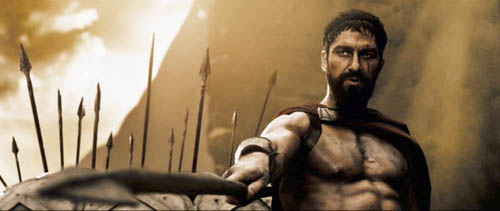
A turning point in digital projection?
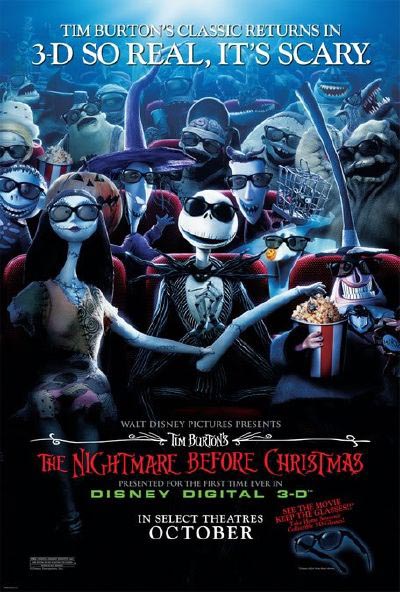
Kristin here–
This past Friday, October 19, marked an historic moment in the history of Madison movie-going. We got our first permanent digital projection set-up, and not just digital, but 3D. The first film to be presented there was Tim Burton’s The Nightmare before Christmas.
We’ve had several big changes in the local theater scene recently. In May the first purpose-built Sundance Cinemas art-film multiplex opened. Madison, I gather, is considered a pretty good moviegoing market for its size. A more modest two-screen theater, the Hilldale, was shut down and demolished. Not such a bad thing, since the Hilldale, a two-screen house, was not aging well. We now have two multiple-screen theaters showing nothing but art films, Westgate and Sundance, as well as the Orpheum theater, University of Wisconsin union, and the Communication Arts Department’s Cinematheque showing art films part-time. Overall the city has a total of something like 60 screens for a population of just over 200,000.
Film vs. Digital: The Film Scholar’s Perspective
As film historians, David and I like to work directly with films. This summer he posted an entry on the joys and possibilities of analyzing films on a flatbed editing table. We used to insist that all the frame enlargements we used to illustrate our books be from film. We acquired hundreds of trailers and patiently cut them up, mounting them in slide frames to use in lectures. Naturally they looked great. For older films, we went to archives and used special photographic equipment to capture frames. Eventually DVD technology got good enough that we had to admit frames captured from them could look as good on the pages of a textbook as reproductions from our slides or negatives. Now Film Art and our other books contain illustrations from a mixture of sources.
But obtaining images for illustrations is a very different thing from watching a movie projected digitally in a theater. The images from a strip of real film have a distinctive look to them. They convey a sense of life. It’s a subtle thing, but the minute grains that make up the blacks, whites, and colors in the frames shimmer slightly from frame to frame. (That’s why a freeze frame makes an image look suddenly grainy. There’s no play of the particles from frame to frame to overlap and create a richness.) Digital projection throws visual information on the screen far faster, eliminating the shimmer and creating instead a fixed-looking image.
So we’re not in a great hurry to see 35mm projection disappear, and we watch the growth of digital exhibition with both interest and some trepidation.
The Slow Progress of Digital Projection
Digital projection has been around for years now, but for most of those years we lovers of 35mm film could largely ignore it. The earliest digital screenings of films in theaters took place way back in 1998, with satellites beaming The Last Broadcast into the few American houses with the proper equipped. Every now and then other digital advances would be touted, but the installation of digital projection equipment around the world has been slow.
Some of the reasons for that slowness are obvious. As usual with such technological breakthroughs, there have been competing systems. There still are. The cost of such a projection system is around $150,000. Tell your theater-chain owner holding nine sites, each with ten screens, that he or she needs to make an expenditure of $13.5 million and see what the response is. Especially if that owner has fairly new, expensive 35mm projectors already installed. The theater owners have argued that the distributors should pay part of the costs. The distributors, naturally, want the exhibitors to pay.
Both groups would gain advantages from digital. Among those are savings in printing up thousands of copies of a given film, usually at over a thousand dollars apiece, and shipping the very heavy prints via overnight courier service. There would be no physical prints going through projector gates and suffering scratches and breakage.
Assuming theater owners will end up paying for most or all of the conversion, they would want to charge extra in order to make up the costs of the equipment. There are undoubtedly people who think digital is superior, and they would pay a higher admission price. A lot of moviegoers, however, couldn’t care less whether the moving image they see in the multiplex is coming out of a 35mm projector or a digital one—and they’re probably not about to pay a dollar or two more to go in the digital auditorium that’s playing The Bourne Ultimatum rather than the one with the old-fashioned 35mm system.
Until now, that is. Modifications of projection systems that allow for 3-D projection have finally given exhibitors a selling point that will get patrons into theaters at advanced prices. Our local multiplex that is showing Nightmare is charging two dollars more for it than for films on its other screens. Apparently people will pay. Nationwide this weekend Nightmare is estimated to make $5,245,000 in 564 theaters, for a per-screen average of $9,122. That’s the highest average in the top 25 films. In contrast, 30 Days of Night, the top grosser at $16 million, has a $5,604 per-screen average.
The question remains, will people remain willing to pay extra for 3-D once its novelty value wears off?
2007 is increasingly being touted as the year when digital installations have speeded up most radically. The conversion will still be a slow process, but for the first time it becomes plausible to think that in the not too distant future digital might kill off 35mm projection. In the October 13-14 issue of The Hollywood Reporter, Gregg Kilday, its editor, suggests that 2009 will be the breakthrough year for digital 3-D. Two major 3-D projects, DreamWorks’ animated Monsters vs. Aliens and James Cameron’s Avatar, will debut within a few months of each other. The real question, he says, is whether enough theaters will be outfitted with digital projection by then. With big theater chains now adopting the new technology, it seems quite possible. (See here for an excellent summary of the current situation of theater conversion and 3-D films in the pipeline.)
Alone with my 3D Glasses
As I was sitting at my desk last Wednesday afternoon, finishing up my David Cronenberg entry, I got a call from a friend of ours, Tim Romano. Tim is an expert projectionist, perhaps the best in town. He’s the one theaters often call on to test new equipment and screen the big blockbusters ahead of time to check for flaws. Not surprisingly, Tim was testing the new digital projector by running Nightmare over and over, as if for a regular day’s screenings, but without an audience. Tim suggested that I might want to drop in and catch a screening. Naturally I headed for we call Point, which is really the Marcus Point UltraScreen Cinema.
As the name suggests, Point is part of the Marcus Theatres Corporation’s chain of 47 theaters (594 screens), scattered across Wisconsin, Illinois, Minnesota, Ohio, North Dakota, and Iowa. Some of the chain’s other theaters will be getting digital projection installations as well. The name Marcus is a big one here in the Midwest, since The Marcus Corporation also owns or manages 20 hotels in the area. Its theater chain is the seventh largest in the country.
Arriving at Point, I received my 3-D glasses from the ticket seller, obtained my snack of choice (Junior Mints), and headed for what proved to be an otherwise empty auditorium. I had missed the opening, but having seen the film a couple of times, I figured that didn’t matter. I was here to see what digital 3-D looks like.
When we go to the movies, David and I usually sit in the center of rows three to five, depending on the size of the screen. This time I sat in row five, but I quickly found the edges of the eyepieces were not wide enough to take in the entire screen. There’s an aisle across the auditorium behind the fifth row, so I sat at the front of the upper section of the house, approximately row eight. That worked fine.
I’m not sure the glasses I had were the same kind that are being used for commercial screenings. Still, my impression is that if you’re used to being down front, sitting a bit further back works well for this film.
Nightmare was originally made on 35mm film using stop-motion to animate puppets. It was transformed into a 3-D film using technology from a company called Real D, which also has been the major player in the move to install digital projection equipment in theaters.
Tim wasn’t, however, projecting Nightmare on a Real D projection setup. Just recently Dolby has moved into digital projection in a big way, and the Point installation is part of its rollout of competing equipment. (For details and other cinema chains using Dolby, see here.) Dolby may have the edge, since its projector works with existing white screens, while Real D’s requires a special silver one.
Happily, the new polarized glasses work better than earlier models. My experience with the older glasses was that one’s eyes sometimes had to struggle to resolve the images onscreen into three dimensions, and one could end up with a headache by the end of the movie. Dolby’s digital 3-D system makes perception of the depth effects automatic and effortless.
Speaking of the glasses, I was amused to note that publicity for the film (see the poster above) shows the characters wearing what look very much like sunglasses. Most probably people still think of 3-D glasses as clunky and cumbersome. This is clearly an attempt to counter that image and make the glasses look cool, like the ones sported by characters in Men in Black or The Matrix.
The depth effect is definitely impressive, even in a retro-fitted film like Nightmare. Because it was not originally produced in 3-D, most of the depth appears to extend behind the screen. I remember seeing 3-D films made in the 1950s that strive to thrust objects out at the audience—most effectively in House of Wax when a carnival barker has a paddle-ball that he bounces directly toward the camera. I rather prefer the depth behind the screen to the depth in front, which tends to be distracting. Whatever the promoters say about people wanting to feel themselves in the movie, I would prefer not to have projectiles coming at my face or actors tumbling into my lap.
The movement of the characters was fine most of the time. I found that rapid action caused a ghosting, blurred effect that was quite different from the rock-steady three-dimentionality of static or slowly moving figures. That ghosting may simply be an artifact of the process of turning 2-D into 3-D, and perhaps films made in 3-D will not have it.
Then there’s the matter of grain and other qualities of 35mm film. Certainly one can’t object to the lack of dust and scratches. The absence of grain is a little disconcerting, but it’s really hard to judge in an animated film like this. Presumably, though, it’s not significantly different from 2-D digital projection, which I’ve never seen. I suppose I shall get used to it.
The Current Trend
So Nightmare provides only a limited indication of what the future holds.
Thus far animated films have made up the bulk of the digital 3-D films released. It’s much easier and cheaper to build 3-D into a CGI cartoon (e.g., Disney’s Meet the Robinsons) than to use it on the set of a live-action film. Indeed, the current generation of 3-D features that include actors have employed motion-capture technology. The proof of that pudding will come with Robert Zemekis’s Beowulf, due out November 16.
The real future of 3-D will depend on it attracting adult audiences, and that means that more live-action films will need to be made. That’s not happening now because the technology remains to expensive, cumbersome, and touchy to be easily used on set. The technology is bound to advance, though.
In the meantime, possibly we can expect that for the near future, digitally equipped auditoriums will be a little like Imax is now. A multiplex might have one Imax screen, but it would never put Imax in all its other theaters. Similarly, a theater owner might be willing to pay that $150,000 to convert one projection system in a multiplex, with digital 3D remaining a special attraction, one which people are willing to pay a little extra for.
If such a scenario is fulfilled, then we may see 35mm and digital share the multiplexes of the world for a long time. You wouldn’t hear me complaining.
